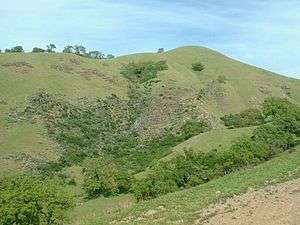California interior chaparral and woodlands
| California interior chaparral and woodlands | |
|---|---|
|
Hillside in Sunol Regional Wilderness, April 2004 | |
 | |
| Ecology | |
| Biome | Mediterranean forests, woodlands, and scrub |
| Bird species | 231[1] |
| Mammal species | 78[1] |
| Geography | |
| Area | 64,600 km2 (24,900 sq mi) |
| Country | United States |
| State | California |
| Conservation | |
| Habitat loss | 12.915%[1] |
| Protected | 18.35%[1] |
The California interior chaparral and woodlands ecoregion covers 24,900 square miles (64,000 km2) in an elliptical ring around the California Central Valley. It occurs on hills and mountains ranging from 300 feet (91 m) to 3,000 feet (910 m). It is part of the Mediterranean forests, woodlands, and scrub biome, with cool, wet winters and hot, dry summers. Many plant and animal species in this ecoregion are adapted to periodic fire.
Flora
These woodlands are varied and rich in plant life. The ecoregion contains areas of grass, chaparral shrublands, savanna dotted with oak, oak woodlands, serpentine soil communities, closed-cone pine forest with small patches of mountain conifers, wetland, marsh, and riverside forest.
Chaparral and oak woodlands are the most widespread plant communities in this ecoregion. The chaparral is composed of diverse shrubs and herbs. These include chamise and several species of manzanita and ceanothus. Gray pine often emerges from the shrubs. Meanwhile, buckeye is extensive and Blue oak is one of the most extensive of the many varieties of oak in the woodlands: scrub oak, coast live oak, canyon live oak, valley oak, and interior live oak.
The pine and cypress communities on the areas of serpentine soil within this ecoregion harbor many endemic species such as milkwort jewelflower. The main trees of this habitat are Sargent cypress and MacNab cypress with California scrub oak.[2]
Fauna
Over seventy species of mammals occur in this rich ecoregion. The endemic mammals include three species of kangaroo rat. Some hundred species of birds occur here. Indicator species are scrub jays, acorn woodpeckers, and wrentits.[2]
Threats and preservation
About one third of the original habitat remains, especially at higher elevations. The trees of Closed-cone pine forest are adapted to open the cones and release seeds for new growth following the heat of forest fires. As fire regulation and suppression becomes more effective these communities cannot renew themselves.
Protected areas of the ecoregion include: Point Reyes National Seashore, Mount Tamalpais State Park, Mount Diablo State Park, Henry W. Coe State Park, Pinnacles National Park, and Carrizo Plain National Monument.
See also
References
- 1 2 3 4 Hoekstra, J. M.; Molnar, J. L.; Jennings, M.; Revenga, C.; Spalding, M. D.; Boucher, T. M.; Robertson, J. C.; Heibel, T. J.; Ellison, K. (2010). Molnar, J. L., ed. The Atlas of Global Conservation: Changes, Challenges, and Opportunities to Make a Difference. University of California Press. ISBN 978-0-520-26256-0.
- 1 2 "California interior chaparral and woodlands". Terrestrial Ecoregions. World Wildlife Fund.
External links
| Wikimedia Commons has media related to California chaparral and woodlands. |
